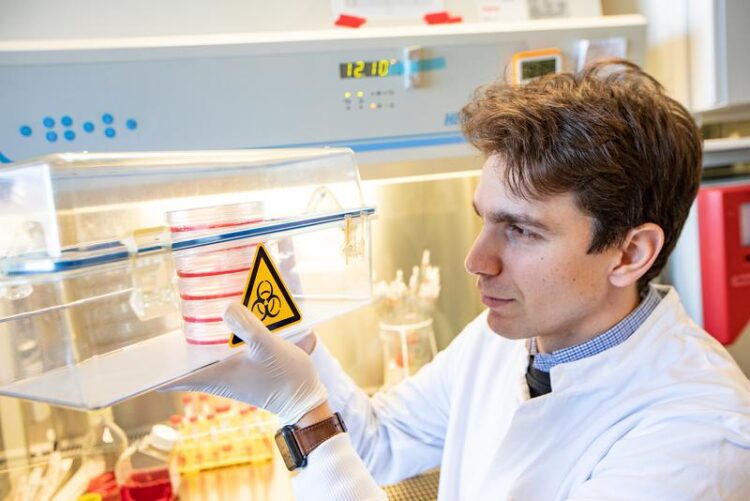2.5 million euros for rapid therapies against viral diseases

In search of new drugs against viral diseases: Young scientist Philippe Vollmer Barbosa conducts research in the iGUARD cooperation project.
Copyright: Karin Kaiser / MHH
The MHH research project iGUARD is also successful in the third round of the SPRIND Challenge and receives follow-up funding to develop antiviral RNA-based drugs.
Despite successful vaccine development, there are still no effective drugs for most viral diseases. In order to achieve a breakthrough, the Federal Agency for Breakthrough Innovations launched the SPRIND Challenge two years ago. The iGUARD (integrated Guided Ultrafast Antiviral RNAi Drug Development) project has already been funded twice and, as a finalist in the third and final round of the innovation competition, is now receiving a further 2.5 million euros for the further development of new antiviral agents.
The research team led by Professor Dr Dr Axel Schambach, Head of the Institute of Experimental Haematology at Hannover Medical School (MHH), and Prof. Dr Armin Braun, Head of Preclinical Pharmacology and Toxicology at the Fraunhofer Institute for Toxicology and Experimental Medicine ITEM, is focusing on RNA-based active substances, using a natural mechanism of our body. The drugs should be able to adapt particularly quickly to different viruses and thus provide protection against emerging infectious diseases.
Targeted blocking of virus replication
The iGUARD research team is focussing on the parainfluenza virus, which primarily affects the lower respiratory tract in children and people with weakened immune systems. It triggers flu-like symptoms, but the course of the disease can also be very severe. The aim is to use RNA interference (RNAi) to prevent the virus from multiplying and spreading in the body. RNAi is a natural mechanism in our cells for switching off genes in a targeted manner. In the process, the so-called messenger RNAs are cleaved and the instructions for building proteins contained in them are destroyed. However, the RNAi system can also be used to block foreign RNAs. In the case of a viral infection, the body forms short RNA snippets that bind like a Lego brick to the right place on the viral RNA, rendering it unreadable and initiating its degradation. As a result, the genetic blueprint it contains is not realised and virus replication is blocked. “We have now developed suitable RNAi building blocks that specifically paralyse different sections of the parainfluenza virus genome that the virus needs to replicate,” says Professor Schambach.
Effectiveness of RNAi candidates successfully tested in lung tissue
RNAi technology uses molecular methods to target the Achilles’ heel of viruses, so to speak. With the help of artificial intelligence, so-called in-silico design, the research team searched gene databases primarily for “conserved” regions. These are essential for the virus and are therefore unlikely to change, meaning that resistance cannot develop. Such a search normally takes months or years. Thanks to a self-constructed development pipeline, this process could be shortened to just a few weeks. “We have successfully tested the efficacy and safety of our RNAi candidates on human lung tissue slices and in 3D cell cultures from human lung epithelium and animal models,” explains Professor Dr Armin Braun, Head of Preclinical Pharmacology and Toxicology at Fraunhofer ITEM. “There, they were able to suppress the parainfluenza virus by 95 per cent. The rest is done by the immune system.”
Method is also suitable for other virus types
In the third funding stage, the researchers now want to work out the effectiveness and safety of the approach even more clearly. “We have set ourselves the goal of developing important steps with a view to clinical application,” says Professor Schambach. In addition, the RNA therapeutic agent is not to be administered with a syringe or as a tablet, but rather inhaled directly into the lower respiratory tract. Appropriate transfer methods have already been developed to deliver the therapeutic RNA directly to the target cell in the lungs affected by the virus. “The long-term goal is to use our iGUARD platform to construct corresponding therapeutics for other known viral diseases.” But the researchers also have their sights set on the next pandemic. Professor Axel Schambach wants to be prepared for this: “With our RNAi technology, we are able to quickly adapt the active substances to unknown, newly emerging virus types in order to develop customised therapies very quickly.”
The iGUARD project is a collaboration between the MHH Institute of Experimental Haematology (Professor Dr Dr Axel Schambach, Philippe Vollmer Barbosa), the MHH Clinic for Haematology, Haemostaseology, Oncology and Stem Cell Transplantation (Professor Dr Dr Adrian Schwarzer) and Preclinical Pharmacology and Toxicology at Fraunhofer ITEM (Professor Dr Armin Braun, Philippe Vollmer Barbosa).
SERVICE:
For further information, please contact Professor Dr Dr Axel Schambach, schambach.axel@mh-hannover.de.
Media Contact
All latest news from the category: Awards Funding
Newest articles
Faster, more energy-efficient way to manufacture an industrially important chemical
Zirconium combined with silicon nitride enhances the conversion of propane — present in natural gas — needed to create in-demand plastic, polypropylene. Polypropylene is a common type of plastic found…

Energy planning in Ghana as a role model for the world
Improving the resilience of energy systems in the Global South. What criteria should we use to better plan for resilient energy systems? How do socio-economic, technical and climate change related…

Artificial blood vessels could improve heart bypass outcomes
Artificial blood vessels could improve heart bypass outcomes. 3D-printed blood vessels, which closely mimic the properties of human veins, could transform the treatment of cardiovascular diseases. Strong, flexible, gel-like tubes…





















